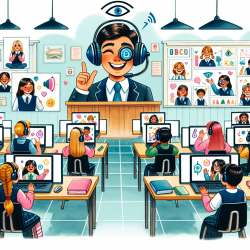As an occupational therapist working in the educational setting, I've witnessed firsthand the transformative power of technology in therapy. The world is increasingly moving towards digital solutions in all areas of life, and therapy is no exception. Today, I want to explore an exciting development in the field of speech therapy: telepractice. This innovative approach is not just a trend; it's a revolution that's reshaping how we provide care and support to our students. If you're curious about how telepractice can enhance speech therapy, you're in the right place. Let's dive in and discover how this technology can inspire us all.
Firstly, what exactly is speech therapy telepractice? In simple terms, it's the delivery of speech therapy services over the internet using video conferencing tools. This might sound straightforward, but the implications are profound. Telepractice breaks down geographical barriers, making therapy accessible to students who might otherwise have difficulty receiving services due to location, mobility issues, or lack of local resources. It's an exciting development that's opening up new possibilities for children and families everywhere.
One of the most remarkable aspects of telepractice is its ability to engage students. Let's face it, we live in a digital age where children are incredibly adept at using technology. By integrating speech therapy into a format they're comfortable with, we can capture their attention in new ways. Interactive online tools, games, and activities make sessions fun and engaging, which can significantly enhance motivation and participation. This is particularly beneficial for younger students who may struggle to stay focused during traditional therapy sessions.
But how effective is telepractice compared to traditional in-person therapy? Numerous studies have shown that telepractice can be just as effective, if not more so, in certain cases. The key lies in the quality of the interaction between the therapist and the student. Telepractice allows for a high level of personal interaction, with the added benefit of convenience and flexibility. Sessions can be easily recorded for review, enabling therapists and parents to track progress more effectively. Moreover, it facilitates a closer collaboration between therapists and educators, ensuring that therapy goals are aligned with educational objectives.
For parents, the advent of telepractice offers a host of benefits. The convenience factor cannot be overstated; receiving therapy at home or in school without the need to travel is a significant advantage. It also allows parents to be more involved in their child's therapy. They can observe sessions, learn techniques, and receive real-time feedback from therapists. This involvement is crucial, as it empowers parents to reinforce learning and practice outside of therapy sessions, thereby accelerating progress.
However, embracing telepractice does not come without its challenges. Access to reliable internet and suitable devices is essential, which can be a barrier for some families. There's also the task of ensuring that students remain engaged and focused during sessions, which requires creativity and adaptability from therapists. But these challenges are not insurmountable. With the right support and resources, telepractice can be a highly effective means of delivering speech therapy.
So, how can occupational therapists get involved in speech therapy telepractice? The first step is to seek out training and resources that can help you transition to this mode of delivery. Many organizations, including TinyEYE, offer comprehensive training programs and support for therapists looking to expand their skills into telepractice. It's also important to stay curious and open-minded, embracing the technology and its potential to enhance therapy outcomes.
As we look to the future, it's clear that telepractice will play an increasingly important role in speech therapy and occupational therapy at large. The benefits it offers in terms of accessibility, engagement, and effectiveness are too significant to ignore. For therapists, it's an opportunity to expand our reach and impact, providing services to students who might otherwise go without. For parents, it's a chance to be more involved in their child's therapy, supporting them every step of the way.
Ultimately, telepractice is not just about using technology for the sake of it. It's about leveraging these tools to provide better care, to connect more deeply with our students, and to inspire progress in ways we never thought possible. As occupational therapists, we have a unique opportunity to lead the way in this exciting field, embracing the challenges and reaping the rewards that telepractice has to offer.
So, to my fellow occupational therapists and the curious parents out there, I encourage you to explore the possibilities of speech therapy telepractice. It's a journey worth taking, one that promises to enrich the lives of countless children and families. Together, let's embrace the future of therapy, inspired by the potential to make a real difference in the world of those we serve.










